
The latest books about Britain
SO MANY BOOKS, so little space to write about them. This issue, we put on the shelf several profiles of the Victorian age —when the sun never set on the British empire. First, we will go down the rabbit hole with Lewis Carroll’s Alice in Wonderland, No. 8 in our countdown of readers’ selections of the most British books of all time. Next, we visit the building of Britain’s empire and the echoes of that empire in the world today. Then, perhaps no individual so personifies the mixed motives of British colonialism as the Scottish missionary-explorer David Livingstone. Finally, it is time for a bit of fun, as we add brief glimpses of recent books that unpack eclectic tidbits of our green and pleasant land. Let’s have a cup of tea, and read!
Alice in Wonderland, by Lewis Carroll. Available in many editions, both soft and hardcover.
WITHIN THE PAGES of Lewis Carroll’s signature novel, Alice in Wonderland, the worlds above and below the famous rabbit hole nowhere intersect. Above the hole the reader finds calm and order, bright sunlight and the gently flowing Thames. Down below, the laws of nature and logic have been turned on their heads. Seemingly, never the twain shall meet.
Things are not always as they first appear, however. For a century and more, children have enjoyed the sheer silliness of Wonderland’s residents, but to the initiated they are a wry reflection of Carroll’s Victorian-era England, or at least Victorian England as Carroll himself perceived it.
The reign of Britain’s very own above-ground Queen of Hearts was a time of rapid change, exemplified by advances in science and by the Industrial Revolution—as well as by an increasing subservience to schedules and timetables that created a manic, rabbitlike response to the dread of running late. (The white rabbit is, in fact, a dead-ringer for every railway conductor I’ve ever met.) Even while industrialization transformed Britain, 18th-century social customs—most notably a rigid class structure in which every card had its proper place in the deck—lingered on.
[caption id="OntheBookshelf_img1" align="aligncenter" width="490"]

Carroll himself was something of a square peg in Victorian Britain’s round hole, and he viewed the world into which he had fallen, through no fault of his own, as a Wonderland in many ways no more strange than Alice’s. A mathematician himself, Carroll had a keen sense of logic and order. He also had a sense of the absurd, and saw many of the intellectual trends of his day in the latter light. In contrast to the mock intellectualism of adults, Carroll seems to prefer the innocent common sense of children, who therefore became, like Alice, the heroines of most of his stories. Alice’s greatest challenge in Wonderland often seems not to be how to return to the aboveground world, as might be expected, but in remaining uninfected by the dangerous and surreal logic of the “adult” Wonderlanders she encounters—an ultimately futile endeavor, since Alice, along with every other little girl, is on an inevitable progress toward adulthood herself. The journey, however, often proceeds in fits and starts and takes many false turns, as Alice discovers to her ongoing frustration when she alternately shrinks and grows at the mere sip of drink or bite of cake. That alone would be frightening enough even without the possibility—a very real one, as Alice learns—that any child may grow up to become a “pig.”
Despite its unpredictability, Wonder-land is seductive and almost preferable to the real(but bland by comparison) contemporary world. Readers can safely give in to its enticements by joining Alice as she tumbles down the rabbit hole. The creatures and situations that visitors to Wonderland will encounter include, famously, a grinning Cheshire cat, a maddeningly absurd tea party, a sagacious caterpillar, a mind-bending croquet match, a thieving knave and a queen with an attitude who seems more than capable of bringing the entire world under her dominion. (Presumably, the real monarch would not have been amused by any suggestion of a similarity.) So well-known are these creations that Carroll’s imagery is said to be more frequently alluded to than is any other literary source, save only the Bible and Shakespeare.
Today’s readers have an abundance of editions to choose from when settling down with this classic, perhaps with a child or grandchild on their knee. Do select one that contains the original illustrations by John Tenniel, which have become classics in their own right, or perhaps the edgier color images of Arthur Rackham.
BRUCE HEYDT
Britannia’s Empire: Making a British World, by Bill Nasson. Tempus Publishing, Gloucestershire, 254 pages, hardcover &doller;37.50.
SIR WINSTON CHURCHILL said that empires of the future will be those of the mind. In one sense, all empires have that element to them, and all frontiers. Churchill, though, would have been the first to say that even ideal empires must have very practical elements in them, too.
Professor Bill Nasson, a South African don who earned his doctorate at Cambridge, tells the story of the world’s greatest empire in Britannia’s Empire. He states, “As the true benefit of all empire lay in the bestowing of order and organization, if need be by calculated force,” Britain’s depended eventually on the “voluntary acceptance of its orderly gains and tranquil benefits.” That seems the basis for today’s Commonwealth, as the memory of empire lingers on there in institutions that still contain much of the reflected genius of the old British empire.
[caption id="OntheBookshelf_img2" align="aligncenter" width="488"]
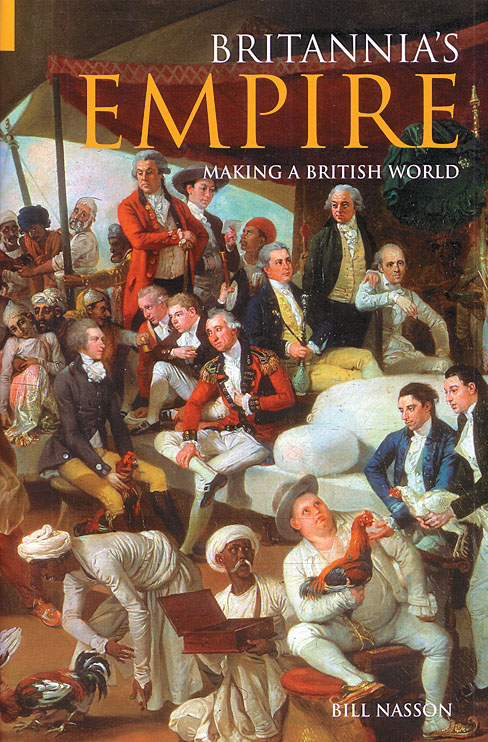
Beginning with the empire’s emergence in the early 16th century, the author covers the diversity of exploration, conquest, evangelization, trade and assimilation, as well as defeat and renaissance. With the 1497 expedition of John Cabot to North America and circumnavigation of the globe by Sir Francis Drake in 1577, the territorial outline was formed whereby British colonial cycles began. From the reign of Elizabeth I through Victoria’s, North America, the Caribbean, Africa, Australia, New Zealand and, of course, Asia saw British territories flourish as conquest and trade progressed.
Thinking America might be the Jewel of Empire for its hoped-for passage to India, British rulers acquired land and property, while becoming a greater sea force than history had ever known. The East India Company had already been chartered in 1600, and India became more crucial in the Sceptered Isle’s overseas policies as infrastructural resources were shifted away from the new United States at the end of the American Revolution. Canada remains a member of the Commonwealth, as are some of the Caribbean islands. The same goes for India, Pakistan, South Africa, Australia and New Zealand, among 53 current members.
The lack of quotations, footnotes or even a few helpful statistics to accompany Professor Nasson’s analysis should have made this book very dry, but it is rich with useful insights. The author’s ability to reflect upon facts and ideas compellingly makes readers think. Both critical of and complimentary to the British empire, the author argues that the British still have a lot going for them.
The progress Britain is making today vis-a-vis the Commonwealth, America, the European Union and the rest of the world has a lot to say about Britain’s being more than “just” an empire of the mind. It is a working polity for the future. To be sure, Britain and America continue to be leaders globally, as is the European Union. Unity has its advantages as long as every partner comprises a democratic people and institutions of productive service to humankind and its environments.
DAVID J. MARCOU
David Livingstone: Mission and Empire, by Andrew C. Ross, Hambledon and London, London, 288 pages, hardcover &doller;29.95.
[caption id="OntheBookshelf_img3" align="aligncenter" width="490"]
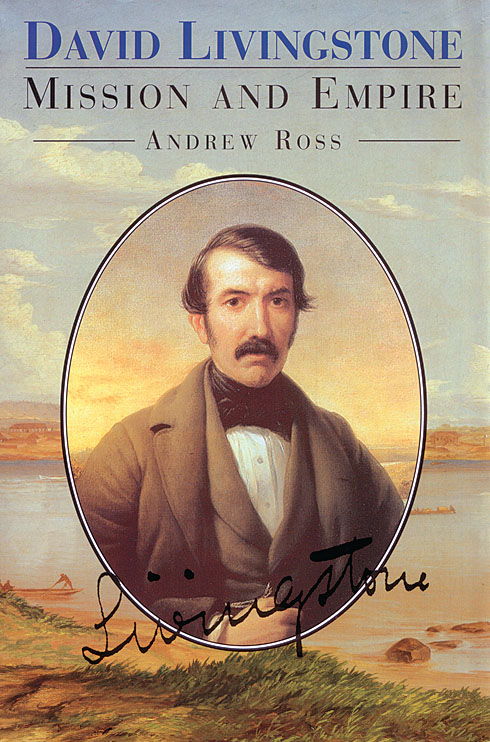
STANLEY, EMERGING unexpectedly from the jungle, doffing his pith helmet and intoning, “Dr. Livingstone, I presume?” is so familiar that it is oft parodied in skits and cartoons without need of further explanation. Yet in spite of such familiarity and numerous accounts of his journeys, including those written by Livingstone himself, most of us will find Andrew Ross’ biography both enlightening and astonishing.
Ross creates a vivid image of Livingstone, his journeys and accomplishments that he hopes is more balanced and accurate than many attempts of the past. To do this, he first provides a wealth of historical and cultural background for understanding Livingstone in both Britain and Africa. More important, he provides Livingstone’s own words, referring liberally to letters, journals and books from Livingstone’s own hand.
Ross enjoys contrasting various views and assessments of Livingstone’s intentions with Livingstone’s own disclosure of his dreams, passions and plans. His familiarity with these writings allows him to reveal contrasts between Livingstone’s private feelings, confessed in his journals, and public statements moderated for acceptance by his British audience. Although obviously sympathetic to Livingstone’s character and passions, this fascinating portrait aims at accuracy, revealing strengths and weaknesses, genius and blunders.
Of particular interest is the breadth and complexity of this account. We gain insight into culture, politics, geography, cartography, racism, transportation, religions, missiology, people groups, medical understanding and practices, societies and the personal psychology of Livingstone and the other players. The reader understands why Livingstone’s contributions to medicine and geography were celebrated. Yet through it all runs the relentless passion of the man’s unrealized dream: his intention to free Africa from the horrors of slave raiding and trading. That this passion arises naturally from his personal faith and theology is clear.
Although he intentionally rejected the strategies and practices of missionary enterprises of his day, there is no doubt that Livingstone saw his adventures and explorations as a specific and intentional missionary endeavor. As he wrote: “No one can estimate the amount of God pleasing good that will be done, if by Divine favour, this awful slave trade, into the midst of which I have come, be abolished. This will be something to have lived for….”
There are a few annoying editorial errors, especially repetition, missing words and a couple of paragraphs that force one to guess at their meaning. Nonetheless, one is drawn into the adventure and tragedy of Livingstone’s life and passions. The issues are compelling, the information is fascinating, and one finds oneself gaining insight about current events by understanding their background. This is a biography well worth reading, not only by those interested in Livingstone, British history, Christian missions or Africa, but by any who are interested in people, the current world or human life.
RICHARD LARIBEE
Where to Take Tea, by Susan Cohen, published by Interlink Books, Northampton, Massachusetts, 95 pages, illustrated, softcover &doller;12.95.
DURING THE VICTORIAN era, tea was transformed from a simple beverage, taken at breakfast or after dinner, into a late afternoon event. As the story goes, formal tea was introduced sometime in the 1840s when the Seventh Duchess of Bedford ordered her maid to serve tea and refreshments at 5 o’clock in the afternoon to alleviate the “sinking feelings” of hunger that she daily suffered during the long hours between lunch and the 9 p.m. dinner hour. To the English, however, tea is more than an excuse for an extra meal. Queen Victoria’s prime minister, William Gladstone, said it best when he observed in 1865: “If you are cold, tea will warm you; if you are too heated, it will cool you; if you are depressed, it will cheer you; if you are excited, it will calm you.” For those who love the drink, tea is an occurrence and a cure-all. In Where to Take Tea, author Susan Cohen gives an overview of the evolution of the world’s most popular beverage and provides a delightful guide to the best places to enjoy it.
The first of this slim volume’s two sections gives a brief history of tea, relating its earliest origins in China and the tea trade. It also provides information on tea paraphernalia, modifications to the teapot, and the different kinds of teas. One of the many sidebars that pepper this book is “The Power of the Leaves,” with a key for reading the dregs in the bottom of a cup. For instance, if the tea leaves form an anchor shape, it signals a voyage in the tea drinker’s future. A peacock means immortality, and a feather signifies a “lack of concentration.”
The author also explains how tea service grew into a ritual. Topics include tea garden parties, tea picnics, traveling tea, tea fashion and even tea-dancing. It seems that afternoon tea from 1912 on could include, along with finger sandwiches, the tango, the turkey trot and the Charleston. Both the Savoy and the Royal Opera House in London still routinely hold weekend tea dances. The first part of the book concludes with a short history of tearooms and teashops—a perfect segue to the next section, a directory of places to take tea today.
[caption id="OntheBookshelf_img4" align="aligncenter" width="490"]
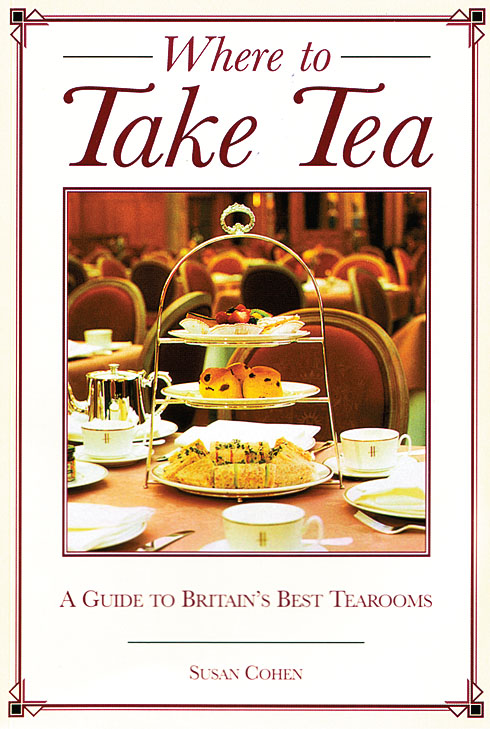
The author divides the last portion of the book into two segments. The first details tearooms in London, and the second does the same for an additional 25 located throughout “The Rest of Britain.” Each entry includes contact information, location, hours of operation, the kinds of tea served and menu highlights. Cohen’s description of each venue vividly captures the atmosphere of some of Britain’s finest tearooms with such entries as this one for the Dorchester in London: “Your afternoon of sheer luxury begins as soon as you sink into one of the lounge’s cozy sofas, or settle on a silk damask upholstered chair. Here you are surrounded by acres of marble, gilded columns, luxurious carpets, Regency mirrors, and marble-topped tables.” The menu includes a “daily-changing selection of six sorts of finger sandwiches, freshly baked warm scones, and delectable French pastries.”
Cohen’s effort is well worth the read for the directory alone. If tea wasn’t your favorite drink before reading Where to Take Tea, it certainly will be afterward.
ALLYSON PATTON
briefly noted:
Resolution: Captain Cook’s Second Voyage of Discovery, by Peter Aughton, Cold Spring Press, Cold Spring Harbor, N.Y., softcover &doller;13.
If you don’t know the real-life adventures of the great Captain James Cook, this is a good place to start. Aughton tells well the story of Cook’s famous three-year voyage mapping the South Pacific and multiplying our knowledge of the world.
Admiral Sir Henry Morgan: King of the Buccaneers, by Terry Breverton, Pelican Publishing, Gretna, La., softcover &doller;14.95. Here is the swashbuckling tale of Welshman Henry Morgan. Long branded a fierce and black-hearted pirate, Morgan in fact was known as the Sword of England, knighted for his service to the Crown against Spain and made governor of Jamaica. Fun forgotten history.
Pubs of the River Thames: From the Cotswolds to the East End, by Mark Turner, Prion Books, London, hardcover &doller;25.
From the Thames Head Inn in Kemble to the Pier Tavern at Isle of Dogs, Turner visits the riverside hostelries that have greeted folk along England’s historic waterway for centuries. This is a beautifully illustrated, clear handbook— delightful for armchair traveling, or planning a most memorable pub crawl.
Lilibet: An Intimate Portrait of Queen Elizabeth II, by Carolly Erickson, St. Martins Press, N.Y., softcover &doller;16.95.
If you would like to get to know the queen beyond the coffee-table books and royal headlines, here is a splendid introduction. Erickson’s biography describes Britain’s monarch as a shy woman with a great sense of humor amidst a life of tremendous responsibility and many sorrows.

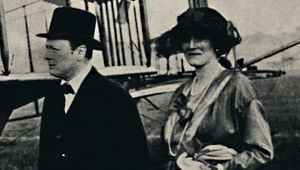
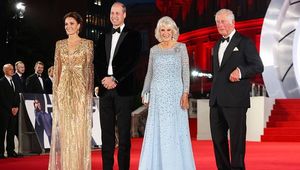
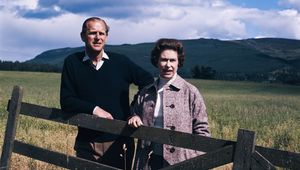

Comments